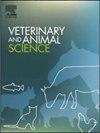The early pregnancy in mares - What do we still not know?
IF 1.9
Q2 AGRICULTURE, DAIRY & ANIMAL SCIENCE
引用次数: 0
Abstract
Equine conceptus development is a critical study area due to its significant implications for the equine breeding industry. Following a high fertilization success rate of 71–96 % (Ball, 1988), it is concerning that 30–40 % of developing embryos may not survive beyond the crucial initial two weeks of gestation, coinciding with the onset of gastrulation (Ball, 1988).
The pregnancy in mares lasts 330–345 days. The underlying molecular mechanisms of the embryonic period are not fully explained in mares. During early pregnancy in mares, the following takes place: the descent of the blastocyst from the oviduct to the uterus around 5–6 days post-fertilization; migration of the spherical conceptus, surrounded by a glycoprotein capsule in the uterine lumen; fixation of the vesicle near the base of the uterine horn around 16–17 days post-fertilization; implantation; development of endometrial cups that produce chorionic gonadotropin, as well as an additional corpus luteum that produces progesterone. In mares, there is no clear determination of what constitutes the early signal of pregnancy recognition. The results of previous research indicate that mechanical stimuli, i.e. the movement of the conceptus in the uterine lumen, trigger a cascade of molecular events in the endometrium responsible for the luteostasis and the maintenance of early pregnancy in mares.
This study aims to provide a synthetic summary of the knowledge we have gained so far about early pregnancy and to attempt to answer the question of what molecular mechanisms underlie maternal recognition of pregnancy in mares.

母马的早孕——我们还有什么不知道的?
马的概念发展是一个关键的研究领域,因为它对马养殖业的重大影响。在71 - 96%的高受精成功率(Ball, 1988)之后,令人担忧的是,30 - 40%的发育中的胚胎可能无法存活超过关键的妊娠最初两周,这与原肠胚形成的开始相一致(Ball, 1988)。母马的孕期持续330-345天。母马胚胎期的潜在分子机制尚未得到充分解释。在母马妊娠早期,会发生以下情况:受精后5-6天左右,囊胚从输卵管下降到子宫;子宫腔内被糖蛋白包膜包围的球形孕胎迁移;在受精后16-17天左右固定子宫角基部的囊泡;植入的;产生绒毛膜促性腺激素的子宫内膜杯的发育,以及产生黄体酮的额外黄体。在母马中,没有明确的确定是什么构成了怀孕识别的早期信号。先前的研究结果表明,机械刺激,即胎儿在子宫腔内的运动,在子宫内膜中触发一系列分子事件,负责黄体稳定和维持母马的早期妊娠。本研究旨在对我们迄今为止所获得的关于早孕的知识进行综合总结,并试图回答什么分子机制是母马妊娠识别的基础。
本文章由计算机程序翻译,如有差异,请以英文原文为准。
求助全文
约1分钟内获得全文
求助全文
来源期刊

Veterinary and Animal Science
Veterinary-Veterinary (all)
CiteScore
3.50
自引率
0.00%
发文量
43
审稿时长
47 days
 求助内容:
求助内容: 应助结果提醒方式:
应助结果提醒方式:


